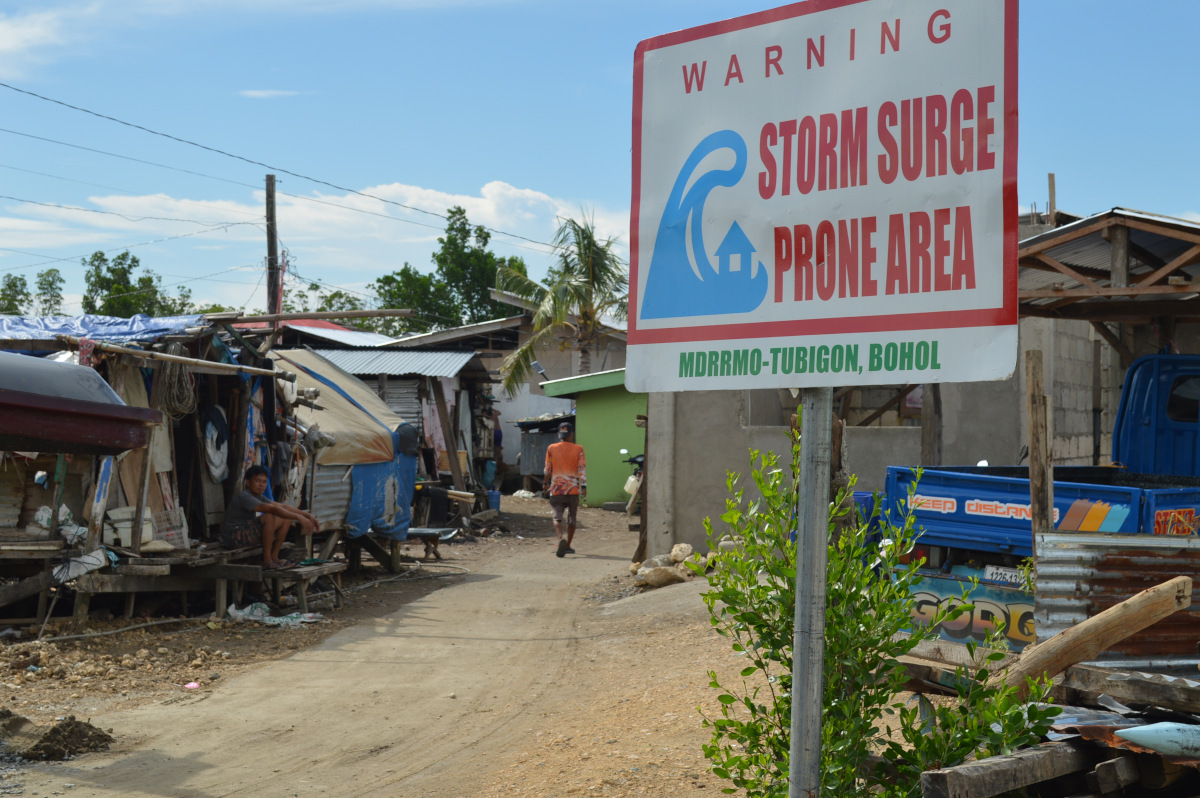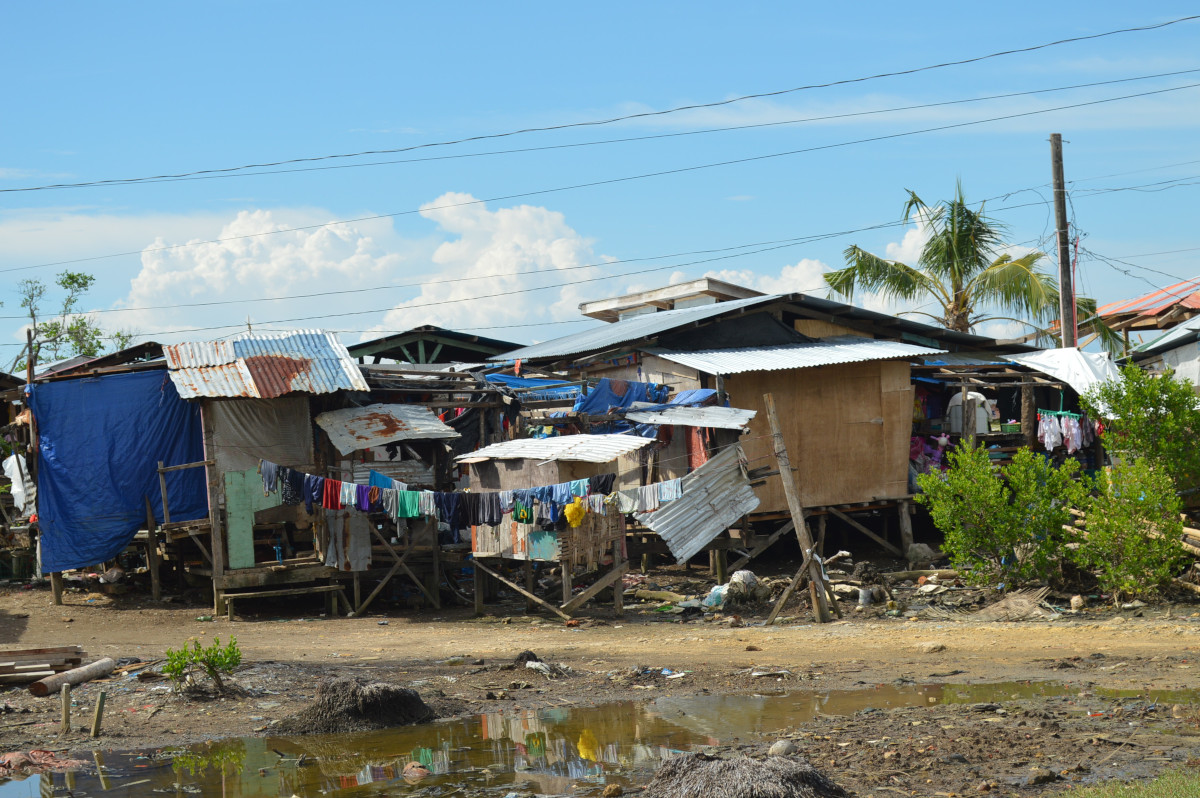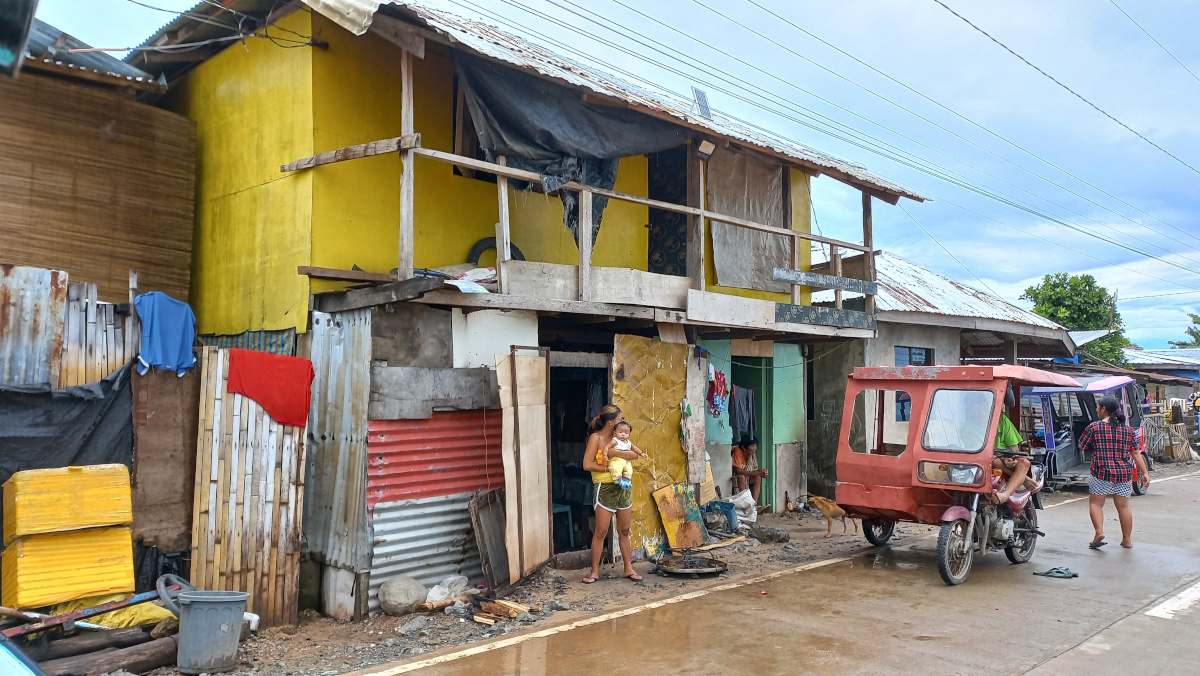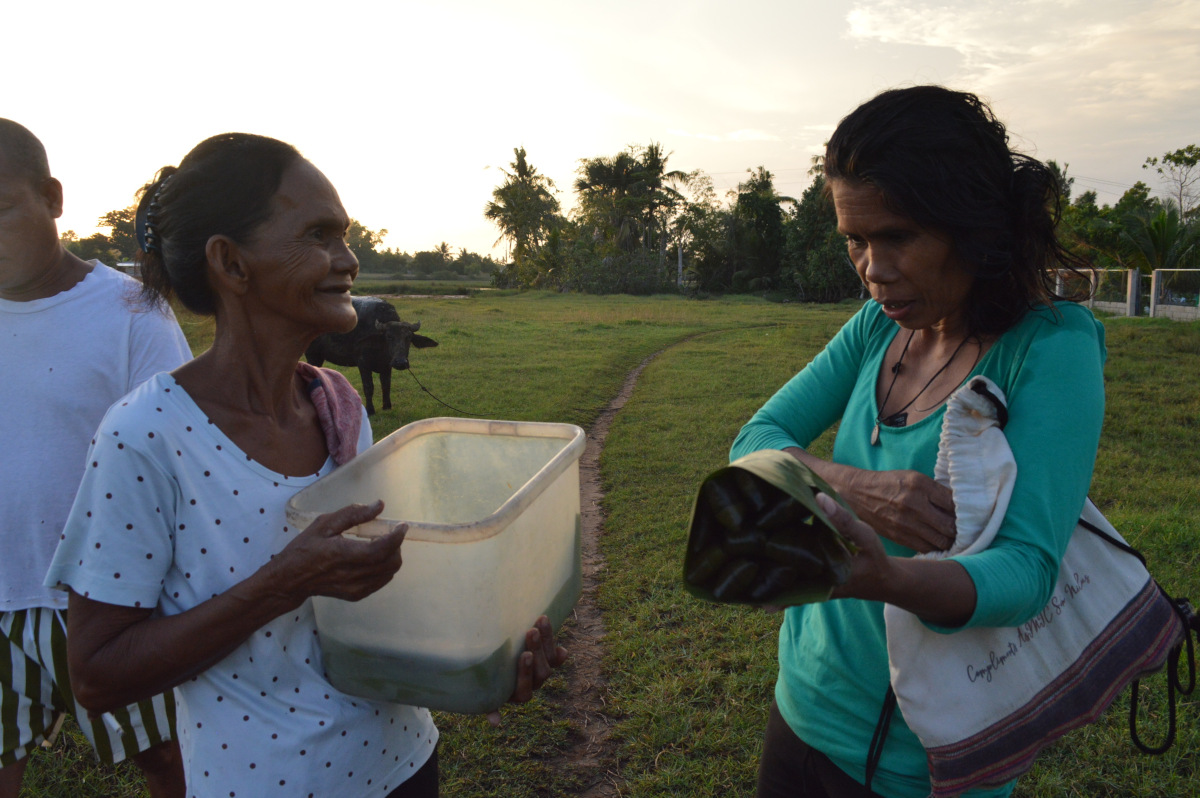Part 1

Two years after typhoon Odette, also known by its international name Rai, battered coastal communities in northern Bohol in the central Philippines, many of those who survived the cyclone are back in the danger zones seemingly awaiting another disaster to happen.
From a side-street in Tubigon town, one of the worst affected by Odette, one can see a billboard warning ‘Storm Surge Prone Area’. But right behind it are makeshift houses leading to what must have been a thriving fishing village now left in shambles by the impact of the strongest typhoon that struck the country in 2021.
“They are back because they have nowhere to go. They have been waiting (for rehabilitation and housing assistance), but these did not come. Up to now, they are still waiting,” said Danilo Cañada, 51, former head of Tinangnan village in Tubigon.
“We submitted a report of the damage, but we received no response, almost nothing, just five kilos of rice,” he lamented during an interview, adding that some 776 houses were severely damaged in the area, with 254 houses completely swept away by the storm that made its first landfall on December 16, 2021.
The ex-village chief said: “There’s a calamity fund, but where is it? The promised assistance for houses totally damaged by the strongest typhoon to hit Bohol has taken so long to arrive. Some two years after the disaster, we are still waiting for the promised help for the people who have suffered enough.”
Cañada, who just completed his third term and did not run for any office in the recent poll, said he himself had to borrow some plywood from a contractor to repair his damaged house, and spent some P30,000 for his house to become liveable again.
“Only 254 are to be given (assistance) by the Department of Social Welfare Department (DSWD), but we were told that it will be given after the local elections,” (October 30, 2023) he said in September.
Froilan A. Cosgafa, Jr., Tubigon’s Disaster Risk Reduction and Management (DRRM) Officer, confirmed that the promised shelter assistance has yet to arrive, despite submission of a report through the national social welfare and development office. Priority for assistance, he said, were those in the town’s Ubay Island that was inundated when typhoon Odette struck.
There is a flood control embankment built earlier in Tinangnan village to prevent water from overflowing, but in the 2021 typhoon, the large volume of water could not be prevented from flooding the town, Cañada said. Cosgafa also noted that one side of the embankment could not be completed because there were residents who refused to leave when it was being constructed.

In sitio Tinago, another part of the village, a community of fisher-folks has returned, with their makeshift houses and tarpaulin walls literally sitting on the remnants of a mangrove forest. Many evacuated from the area after typhoon Odette hit but some stayed in makeshift dwellings on a bridge nearby while waiting for rehabilitation work.
Local officials earlier talked about a relocation site for the mangrove community, but so far one can see only a basketball court and some bunkhouses built for the survivors of the 2013 earthquake. Besides, residents of Tinago said they want to be near the sea, their source of livelihood.
Coastal communities’ woes
These stories are not unique. Coastal communities around the world are facing the consequences of government inaction as increased storm surges, severe disasters and other climate impacts continue to destroy their lives and livelihoods.
The Philippines is one of the world’s most disaster-prone countries. Located in the intersection of major tectonic plates and at the center of a typhoon belt, its islands are regularly impacted by floods, typhoons, landslides, earthquakes, volcano eruptions and droughts, according to the Asian Disaster Reduction Center (ADRC). Annually, an average of 20 tropical cyclones enters the Philippines, of which five to seven cause significant damage, the center says.
On December 16, 2021, while many were still reeling from the effects of the Covid-19 pandemic, typhoon Odette struck central and southern Philippines, displacing nearly four million people who depend on farming and fishing as main sources of livelihood, and destroying 415,000 houses.
“The Philippines faces the Pacific eastern basin. The eastern part of the country faces the northern Pacific Ocean, that’s where tropical cyclones develop, and 80% of them enter the Philippine area of responsibility (PAR),” according to Leonardo Samar, officer-in-charge of the PAG-ASA Alburquerque Bohol Doppler Weather Surveillance Station.
Climate change, he said in an interview, has resulted in increased frequency of typhoons (between 1951 and 2015), averaging 20 typhoons a year, severity of natural disasters, sea level rise, extreme rainfall, resource shortages and environmental degradation. He noted that while the frequency of typhoon occurrence has declined in the past five years, the intensity has increased to 170 kph and above, two of which reached super typhoon levels — Haiyan in 2013 (300 kph) and Rai in 2021 (200+ kph).
“The combined effects of continued temperature increases, changes in rainfall and accelerated sea level rise, and tropical cyclone occurrences, including associated storm surges, expose coastal communities to higher levels of threat to life and property,” a PAG-ASA (Philippine Atmospheric, Geophysical and Astronomical Services Administration) report says. (https://prsd.pagasa.dost.gov.ph) They endanger vulnerable groups, such as the elderly, women, children and persons with disabilities.
There are many different paths forward, from migration and resettlement to natural storm buffers and financial assistance to rebuild. But the spending for disaster risk management can be unpredictable and inconsistent.
While changes to the Philippines’ Disaster Risk Management (DRM) regulations have helped mainstream adaptation into local development plans, questions still remain about how the funds are used, delayed, misused or unutilized – and if they’re really reaching the people who need them.
How the Philippines’ disaster risk management has changed
Under the old Presidential Decree 1566, which was enacted in 1978, disaster management centered around the hazard and impacts of a disaster. Most of the plans involved only the provision of relief goods and infrastructure, like dikes and flood control systems. The national and local government units were mainly reactive, and operated on a calamity fund when an area was declared in a state of calamity.
In 2010, a shift took place to more pro-active interventions in the country’s disaster risk management (DRM). Many institutions and organizations related to DRM exist in the country—all aiming to build the capacity to handle disaster risk at the local levels.
Republic Act 10121, also known as the Philippine DRRM Act of 2010, (https://www.officialgazette.gov.ph/2010/05/27/republic-act-no-10121) has been a major driver for the establishment of Municipal Disaster Risk Reduction Management Councils (MDRRMC).
In general, this shift in DRRM Act has helped facilitate in mainstreaming mitigation and adaptation into local development plans, and allowed local disaster risk reduction and management Funds (DRRMF), formerly called calamity funds, to be used to support risk management activities, according to Dr. Anthony Damalerio, Bohol Provincial DRRM Officer.
The DRRM Act decrees that local government units must allocate at least 5% of their estimated revenue from regular resources to their DRR and adaptation plans. Of this amount, 30% is set aside for a Quick Response Fund (QRF) for relief and recovery, leaving 70% of these funds available for pre-disaster and adaptation measures.
“This puts more emphasis on strengthening people’s capacity to absorb stress, maintain basic functions during a disaster and bounce back better from disasters,” says the OCD DRRM Capacity Enhancement project (Phase 2) completion report. (March, 2023)
In the case of Tubigon town, its total local DRRMF for 2022 was P18.33 million. Of this, some P5.28 million was allocated for quick response while 70 a little over P13 million) was earmarked for mitigation and adaptation.
An examination of the town’s DRRM fund utilization report in the 4th quarter ending December 31, 2022 showed that only about P2.272 million was spent under QRF, mainly for relief goods and other supplies, post- disaster assessment and needs analysis, clearing operations, the management of the dead and missing, and water rationing. It was not even half of the allotted sum.
There was an unutilized amount of a little over P3.0-M under QRF and almost P6.60-M under the mitigation fund. This was the year right after Odette struck and devastated the town and other mainland coastal villages. It was the same case of disaster fund underutilization in 2021.
Asked for an explanation for the unutilized DRRM funds in Tubigon, Cosgafa said there were many donors for the victims of the typhoon Odette that time so they did not consume their budget, adding that the unused fund went to a trust fund.
Lingering traces of disaster

Here and there, traces of typhoon Odette’s fury still linger in towns where the howler made a landfall—abandoned roofless buildings, makeshift or partially repaired houses, and gnarled steel roofing, reminding residents and officials of work yet to be done.
Survivors are trying to recover and rebuild their lives with whatever resources available and pick up the pieces of their disrupted existence in the absence of clear relocation plans. Despite a legislated disaster risk reduction management fund that mandates, among others, the acquisition of land for resettlement, site development, construction of local public infrastructure to reduce risk, and other adaptation measures, the aid has not materialized.
Rodel Gonzales, councilor of Tapon village in Ubay, 124 km from capital Tagbilaran, says: “Up to now, many in our place have not fully recovered from the effects of typhoon Odette that swept everything we had, and damaged the boats used for fishing, the people’s main livelihood.”
Many houses still need repair. The number one need, he points out, is a house to live in and regular source of livelihood. Some have resorted to selling fish in the market, drying salted fish for sale, driving the tri-sikad (pedalled tricycle), working in construction projects, and selling dried fish to survive.
“They can recover fully only if they have regular source of income,” he said, adding that those who got P10,000 assistance to re-build their house spent the money for food for their children (average of 4 to 7 in a household) since they lost their source of income right after the typhoon.
They are not allowed to live near or on the shore, or build a house there, he said, but can only stay on the landed side. Many, however, still try to build a shelter where they used to be since they do not own land at all, Gonzales said.
A group of five women from Tapon village gathered in the barangay hall observed that those whose houses were totally damaged were supposed to get assistance of P10,000. Some 300 households did receive assistance, but some did not. “Our assumption was that those totally damaged will get P10,000, and those partially damaged will get P5,000. Since our houses were not totally swept by the typhoon, we got nothing,“ one of the women said.
“We just accepted whatever was given, like the three galvanized iron roofing from the parish church, and what we call 3-3-3, that is, three packs of noodles, three cans of sardines and three kilos of rice. We just laugh at our problems. Later the DSWD told us that ‘totally-damaged’ means those who have no place to stay,” one woman who did not want to be identified, said.
There are those who have not received anything, while those who received P10,000 cash assistance to help rebuild their houses used the money for food since they have children to feed.

Food is the priority rather than building a house, and to earn some income, others have put up some enterprise micro-business, like selling home-made vinegar, nail painting, disco lights and music service, electronic repairs, and sari-sari stores.
A number of residents of coastal areas like Tapon are considered “informal settlers” or internally displaced persons (IDPs), an issue that needs to be addressed in order to achieve an inclusive, sustainable future. Some came to the town from the village to work in the various service and sales establishments, but could not afford the high cost of rental that they settle in pockets of slum areas.
Eric Putanda, 21, who works as a bike assembler in Población Ubay, says: “We are back to our makeshift house, but it is not yet complete. There are six of us, including my father. My mother died. Our roof and wall had been blown off. We are back to the same area to have a place to sleep in using whatever was left, just a shack, mosaic kind of shelter (barong-barong, tapak-tapak).”
Initially, they could not get assistance to rebuild their homes since they were told that only those whose houses were totally damaged were to get housing aid. Putanda, however, managed to get P4,000 from the provincial capitol, a three-hour ride from Ubay, through an acquaintance. On record, he was supposed to get P5,000, but got only P4,000, which he used to buy 10 pieces of the “thinnest galvanized iron” for roofing.
In a change of plan, Ubay town held a ground-breaking ceremony in December 2022 at Camambugan village for an evacuation center, not a relocation site as earlier mentioned by town spokesmen.
(To be continued: Poor communities most vulnerable to natural hazards)


